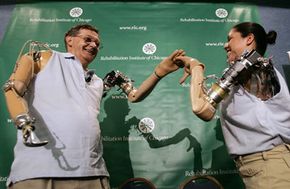Cutting-edge Prosthetic Limbs
One of the most cutting-edge technologies used to control prosthetic limbs is called targeted muscle reinnervation (TMR) and was developed by Dr. Todd Kuiken at the Rehabilitation Institute of Chicago. To understand TMR, you need to know some basic physiology. Your brain controls the muscles in your limbs by sending electrical commands down the spinal cord and then through peripheral nerves to the muscles. Now imagine what would happen to this information pathway if you had a limb amputated. The peripheral nerves would still carry electrical motor command signals generated in the brain, but the signals would meet a dead end at the site of amputation and never reach the amputated muscles.
In the surgical procedure required for TMR, these amputated nerves are redirected to control a substitute healthy muscle elsewhere in the body. For example, the surgeon might attach the same nerves that once controlled a patient's arm to a portion of the patient's chest muscles. After this procedure, when the patient attempts to move his or her amputated arm, the control signals traveling through the original arm nerve will now cause a portion of chest muscles to contract instead. This is valuable, because the electrical activity of these chest muscles can be sensed with electrodes and used to provide control signals to a prosthetic limb. The end result is that just by thinking of moving the amputated arm, a patient causes the prosthetic arm to move instead.
Advertisement
If electrodes can sense the electricity caused by muscle contractions, why can't they just go to the source of the information and measure the electrical signals carried in the nerves, or even the brain? The answer is that they can, but recording from the brain and nerves is more challenging for several reasons. For example, electrical signals in the brain and nerves are very small and hard to access. The field of neural interfacing is dedicated to developing ways to listen and communicate with the brain and nerves.
As an example of neural interfacing technology, scientists can implant micro-scale electrodes in the brain to listen in on brain activity. When the patient mentally tries to move his or her amputated limb, the microelectrodes can intercept motor command signals generated in the brain, and these signals can then be used to control a prosthetic device. One exciting implementation of this technology comes from lab of Dr. Miguel Nicolelis lab at Duke University. Remarkable video footage documents the ability of monkeys implanted with microelectrodes to use their thoughts to control a prosthetic arm to feed themselves snacks.
Future advances in neural interfacing will allow artificial devices to more effectively stimulate the nerves or brain in order to restore a sense of touch and allow patients to feel their artificial limb. This capability will go a long way in closing the gap between prosthetic limbs and the natural limbs they're designed to replace.
These types of technological innovations are just some of the examples that show how the field of prosthetics is constantly advancing. While the challenges are great, remarkable progress has been made over the past few decades, and dedicated researchers around the globe are working each day to make prosthetic limbs as close as possible to the real thing.
Follow the links below for lots more information about prosthetic limbs and related topics.
Related Articles
More Great Links
Sources
- "History of Prostheses." University of Iowa Hospitals and Clinics Medical Museum. 6/5/2008. http://www.uihealthcare.com/depts/medmuseum/wallexhibits/body/histofpros/histofpros.html
- "History of the study of locomotion." 6/5/2008. http://www.univie.ac.at/cga/history/
- Kelly, Brian. Pangilinan, Percival. "Lower Limb Prosthetics." 6/5/2008. http://www.emedicine.com/pmr/topic175.htm
- Kelly, Brian. Pangilinan, Percival. "Upper Limb Prosthetics." 6/5/2008. http://www.emedicine.com/pmr/topic174.HTM
- "Prosthetic FAQ's for the New Amputee." National Limb Loss Information Center. 6/5/2008. http://www.amputee-coalition.org/fact_sheets/prosreplacprof.html
- "Prosthetic Parts and Options." Merck Manual Home Edition. 6/5/2008. http://www.merck.com/mmhe/sec25/ch307888/ch307888b.html
- Rossbach, Paddy. "When to Replace a Prosthesis." 6/5/2008. http://www.amputee-coalition.org/fact_sheets/prosreplacprof.html
- Thurston, Alan. "Pare and Prosthetics: The Early History of Artificial Limbs." ANZ Journal of Surgery. 77:1114-1119. 2007.
- Wilczynski, Krzysztof. "Pirates! Legend - Common Misconceptions." 6/5/2008. http://www.piratesinfo.com/legend/treasure/common.html
